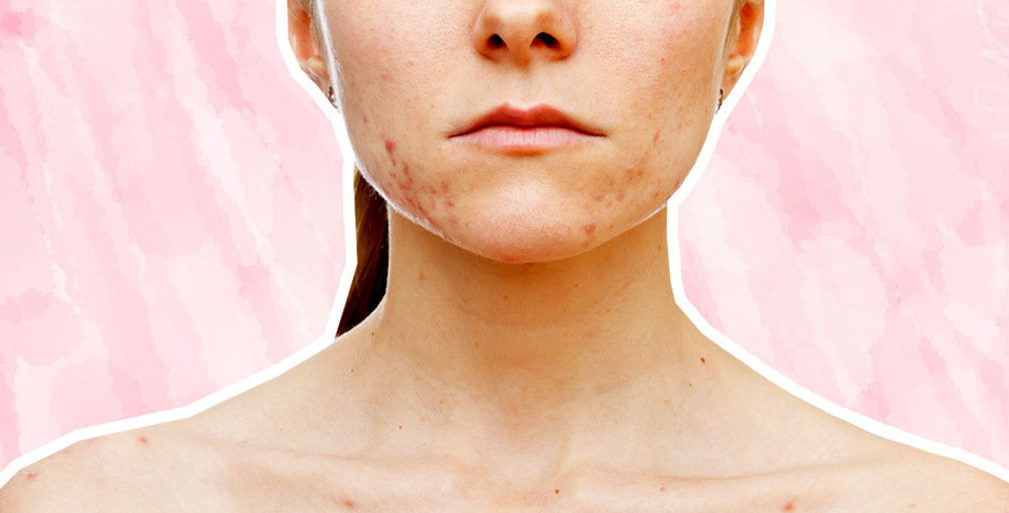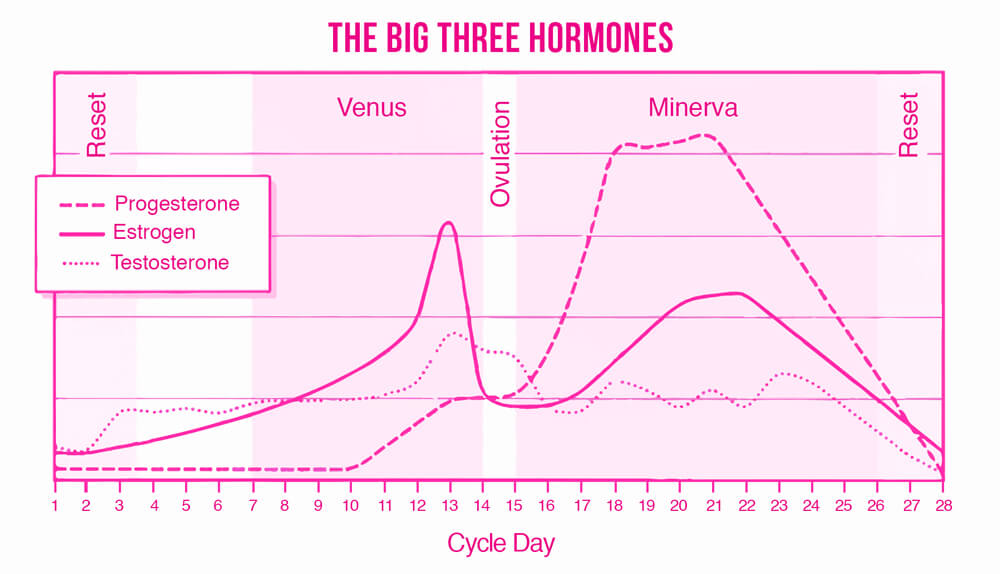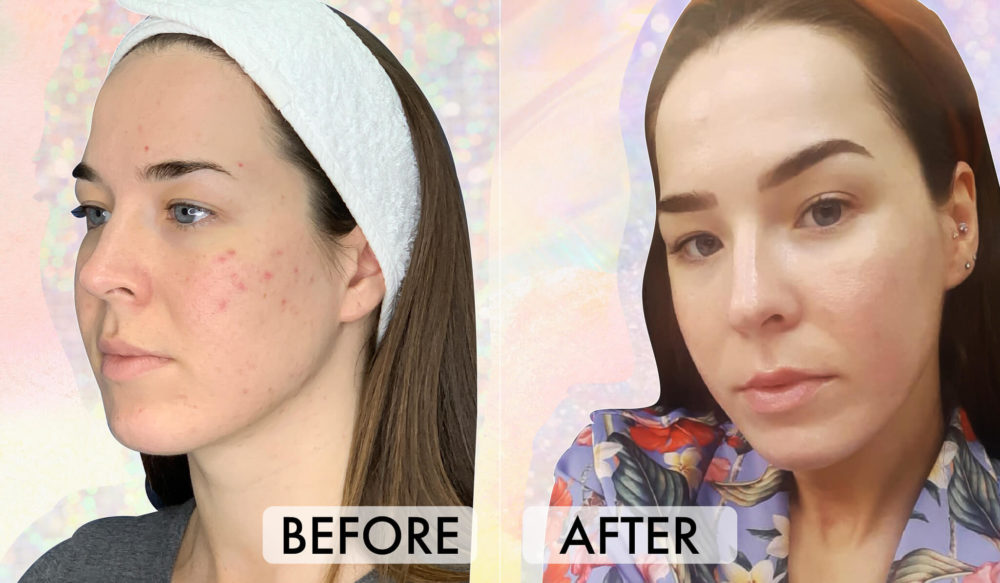The Lowdown On Hormonal Acne And How To Treat It

Most of us will experience hormonal breakouts, it’s just a part of life. In fact, most of you will be all too familiar with the classic PMS breakout, hence why we’re continuously asked in our comments section how to handle hormonal breakouts. So, we reached out to Dr. Rebecca Booth, a hormonal expert, OBGYN, and Founder of VENeffect, an anti-aging skincare line that caters to hormonal changes. She gave us the full lowdown on how your hormones affect your skin and how to handle hormonal acne like a pro.
What is Hormonal Acne?
Hormonal acne is commonly known as a breakout triggered by a hormonal change. However, Dr. Booth notes that “There are many experts in the field of dermatology that feel all acne is hormonal.” Explaining that, “While there are characteristic patterns that demonstrate specific triggers such as PMS time, essentially every type of acne is influenced by hormones.”
However, Dr. Booth does add that “There are some characteristics that women see differently from men, this may be used to describe ‘hormonal acne.’ For example, 85% of women report a worsening of acne in the premenstrual time. Also, it is common to see acne develop in the perimenopause, around the mid-40s until menopause ensues. The physical findings are essentially the same with some anecdotal evidence suggesting that perimenopausal acne may occur more commonly around the jawline as opposed to adolescent acne, which shows problems on the cheeks and forehead.”
How Your Hormones Impact Your Skin
“Hormonal fluctuations have a very strong impact on the skin in multiple ways,” Dr. Booth tells us. As a menstruator, you’ll probably be familiar with how your skin changes throughout the month. Most typically, in correlation with your period, and you’ll have probably noticed that before your period or during your period your skin begins to act out.
Dr. Booth explains the science behind these changes: “With regard to breakouts, it is all about the relationship between testosterone and estrogen. While both hormones have positive effects on the skin in isolation, when testosterone dominates estrogen such as during the premenstrual time or in times of hormonal imbalance, sebum is increased as is inflammation, leading to more breakouts.”
However, it’s not all breakouts, as there is a point of time when your skin clears (hallelujah!). Dr. Booth says, “The most optimum time for clear skin is when estrogen is at its peak, such as in the pre-ovulatory week, what I call “The Venus Week.” During this grouping of days, estrogen reduces pore size and stimulates the microbiome of the skin as well as having positive effects on collagen, elastin, and hyaluronic acid – the elements of glowing skin. Testosterone is still quite present; in fact, it also peaks just before ovulation, adding lubricity to skin with increased sebum. It’s only when the perfect ratio of estrogen dominating testosterone is disturbed that skin is destabilized, resulting in the potential for blemishes.”
When You’re Most Likely to Breakout
As always, with any skin or body concern, knowledge is power; when you’re aware of an issue, you can be proactive and even start to take preventative measures. This is particularly true with regard to hormonal breakouts. Dr. Booth explains when you’re most likely to experience a hormonal breakout: “Women will typically see more breakouts during the premenstrual part of their cycle, usually beginning around cycle day 21, then clearing about the third day of the menstrual period [day 3 of your cycle]. Some women will also see a bit of blemish form just after ovulation when estrogen declines a bit, and progesterone begins to be the dominant hormone.”
“Estrogen has a very powerful effect on suppressing blemishes by reducing pore size and supporting the microbiome of the skin. Progesterone is neutral with regard to the skin but can increase insulin resistance… A risk factor for the blemish in the two weeks of progesterone dominance during the cycle (the two weeks before the menstrual period).”
Posts You'll Love:
How to Change Your Skincare Routine to Combat Hormonal Acne
The best way to soothe acne-prone skin is by having a consistent regime that helps target and regulate oil production, as well as reduce any dead skin build-up. Dr. Booth advises, “To suppress hormonal acne, cleanse daily with a gentle, fragrance-free enzymatic system like the VENeffect Pore Minimizing Cleanser, $60. Periodic exfoliation using a scrub like the VENeffect Micro-Exfoliant, $60, will also help clear sebum and minimize pores.” We also love to use the WISHFUL Yo Glow Enzyme Scrub, $39, two times a week to slough away dead skin and brighten skin tone.
Another key element to maintain is hydration – if your skin is dehydrated, it’s more likely to produce oil in an effort to compensate for the lack of moisture. For this reason, Dr. Booth notes that’s important to, “Follow cleansing with a moisturizer rich in phytoestrogens, plant-based estrogens found in the nuts, seeds, and bark of the healthiest plants that work topically on the skin: The key technology we used to formulate VENeffect Skin Care, is designed to optimize skin hormonal balance.”
During the PMS period, Dr. Booth adds, “It’s particularly important to lean into a skincare regimen designed to help address the blemish, increased pore size, and loss of elasticity and luminosity that accompanies this low estrogen phase of the hormonal cycle. For inflamed blemishes, spot treatment with anti-blemish solutions like the VENeffect Skin Calming Mask, $60, are helpful.” And this is also a great time to be using anti-blemish tonics in your routine, like the Versed Skincare Just Breathe Clarifying Serum, $20, which helps to decongest your skin with breakout-soothing willow bark extract and zinc.
Diet Tips to Help Your Skin

While you may be aware that your diet impacts your skin, Dr. Booth reveals that it can also influence your hormone levels, thereby having a great impact. She explains, “Sugar and processed carbs cause insulin to spike, and this has a negative effect on the ovaries, causing them to thicken on the surface and inspiring the ovarian surface cells to make excessive testosterone.” Adding that this hormonal fluctuation will have a knock-on effect on your skin, “Even worse, as the surface of the ovary thickens, the dominant egg cannot mature properly, resulting in even more blemishes due to not ovulating regularly.”
Here are some of Dr. Booth’s diet tips to help lessen acne:
1. “Eat foods that stabilize your blood sugar and are high in plant estrogens (phytoestrogens) such as plant protein: Nuts, nut butters, seeds, lentils, legumes, and seedy fruits (berries).”
2. “Avoid sugar and starchy vegetables, fast and processed foods.”
3. “Go organic with all of your choices whenever possible. Herbicides and antibiotics in conventionally farmed foods alter the pH of your skin and allow for more inflammation”
4. “Don’t binge or purge. Episodic patterns in energy and insulin spikes will trigger hormonal flux and aggravate blemish”
5. “Foods high in prebiotics, such as high fiber fruits and veggies, onions, garlic, leeks, and lentils will support a healthy skin microbiome that naturally suppresses blemish.”
6. “Drink more water. Skin needs water to maintain elasticity, so drink up and avoid excess caffeine, which can dehydrate, causing dullness in the skin.”
7. “Keep alcohol to a minimum. Alcohol will cause insulin spikes and can make your liver metabolize hormones unevenly, upsetting the hormonal balance and increasing blemish and ruddiness.”
How to Use Oral Contraception to Treat Hormonal Acne
 Source: Kanuttawut/Shutterstock
Source: Kanuttawut/Shutterstock
Many women are prescribed the contraceptive pill to help regulate their hormones, thereby lessening hormonal breakouts. Dr. Booth supports this practice stating, “I often recommend certain birth control methods to help with acne. The most common form of hormonal birth control is known as “combination contraception.” This involves combining two hormones: estrogens and progestins to temporarily pause the fertile cycle and steady the fluctuation of hormones. Examples include most oral birth control pills, the contraceptive patch, and contraceptive vaginal rings. The consistent estrogen component of these products can stabilize and suppress negative changes that affect the skin.”
Although, Dr. Booth adds that the effects are not immediate, “While it takes about three months to see peak benefit, estrogen in combination contraceptives suppresses both sebum formation and pore size. Contraceptives that have a stronger estrogen component tend to be more suppressive of acne.”
As with the majority of treatments, there’s no one-size-fits-all, so check in with your practitioner before you start taking the pill. Dr. Booth begins by stating, “Combination contraceptives are an ideal way to help a menstruator in her reproductive years who is struggling with acne, as long as she does not have a high-risk factor for taking birth control pills or other estrogen-containing contraceptives.” However, if you’re a “Menstruator who smoked after the age 35, or has a clotting disorder or migraine headaches with aura, you’re not a good candidate for combination contraceptives. Fortunately, there are other approaches that can be safe for women in these high-risk groups.”
For more information on how your hormones affect your skin, read this.
Disclaimer: Every product we review has been independently selected and tested without bias by our editorial team. Although some brands allow affiliate links, we never take payment to review products, so we may earn a commission if you purchase a product by clicking on one of our links.























Leave a comment